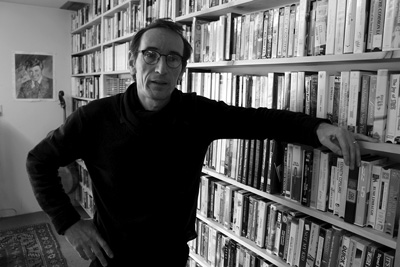Arts and Culture April 2015
Music from snippets and sketches
De Jong, cellist and pioneer of sampling, celebrates first solo album
 By JOHN SEVEN
By JOHN SEVEN
Contributing writer
NEW LEBANON, N.Y.
The cellist Paul de Jong is best known for his decade of work as one-half of The Books, a duo whose compositions made extensive use of sampling, the capturing of short bits of recorded sound. Four years after The Books parted ways, he has completed his first solo album.
John Seven photo
Cellist Paul de Jong is best known for his work as one half of The Books, a duo that created one-of-a-kind songs that made extensive use of sampling, particularly of spoken word.
De Jong and his decade-long collaborator, Nick Zammuto, parted ways four years ago. Since then Zammuto has released two albums under his own name, while de Jong has stayed under the radar.
Where has he been up to? The simple answer is: just about anything that appealed to him.
“I’m easily distracted,” de Jong said. “I have easily 30 projects going at the same time, and if one project is in danger of getting completed, I’ll just start another five.”
De Jong’s new album, “IF,” on the Temporary Residence label, uses many of the signature sampling techniques of The Books, but it also expands into musical territory far beyond that. It marks the end of de Jong’s four-year journey to find out exactly who he is as a post-Books solo artist.
“I had to reinvent myself,” he said. “If you’ve collaborated for 10 years and then you’ve had a life before that, you know, as a marginal figure, then you can’t really pick up where you left off because you’ve changed in a decade, so it takes awhile. You have to look at who you were before that, because you’re going to need that. But in the end there’s nothing more you can do with it than mine a little bit. You have to carry it into your current decade.”
De Jong has taken his decade with The Books and transformed it into his own routine, either building songs from audio sketches or at least drawing music from other sources to complete them. In his work, tiny experiments develop into larger presentations.
“In the era of computers, you can make a thousand cuts in an hour, and you try something out, it doesn’t work, then you throw it out,” de Jong said. “Sketching with sound has become infinitely easier, which is wonderful, because I do sketch every day, something. That’s where most of my ideas come from.
“I make sketches, I’m cutting samples and doing busy work with digitizing stuff, and I hear a certain sample and I hear another sample I like,” de Jong explained. “And I’m going to try something out with that and make a little sequence with loops and things, see how it works, put it backwards, whatever I do with it, until it has run its course and I move on. So I save it. But there are all these little beginnings -- little sketches, like little drafts.”
Collecting since childhood
De Jong pulls his samples from his own vast personal archives, which include about 5,000 cassettes, 5,000 videos and 1,500 LPs. That collection is still growing and has the potential to provide literally tens of thousands of individual samples.
“It’s this enormous library system of fragments, single words, musical notes,” he said. “Two-thirds is spoken word -- that really is my instrument, other than instruments I really play, like cello. The sample library is my instrument. There is maybe a thousand times more in there than I’ll ever use in my music, because you never know when something is going to fit. You need a thousand times more to get that one sample that’s just going to fit.”
De Jong traces his audio obsessions to a very specific item from his childhood in the Netherlands— a box of 7-inch records that his parents gave him.
“I listened to radio from a very young age,” de Jong said. “I mean, 3 years old I was pretty much glued to the radio, music or talk. My parents gave me a radio with a record player on top when I was 5, and they gave me a box with 7 inches that was accumulated over the years. I can bring back my deepest musical influences that make me what I am, a great deal of what I am, to my deepest roots, right back to that box.”
The box contained excerpts from Bach’s St. Matthew Passion and violin concertos, but it also had recordings of medical quizzes and one for a heart- murmur diagnosis — de Jong’s father was a doctor — plus the Beatles’ “Love Me Do,” Reader’s Digest advertising records, and much more.
His childhood record player also featured a 16-rpm setting that transfixed young de Jong, allowing him to slow his records down so much they didn’t sound like what they were anymore.
“That kind of stuff sounded beautiful,” he said. “That’s what I do now. I’m just doing it on a larger scale.”
De Jong started learning to play the cello when he was 5. At 7, he wrote poetry on his mother’s old typewriter. His childhood was filled with trips to concerts and museums. He absorbed it all, eventually working in a music and theater collective with his friends and writing poetry of his own.
He has cut up analog tapes to create audio works since he was 13, first with cassettes and later with reel-to-reel tapes. These projects required precision, patience -- and a tolerance for failure.
“I used to cut cassettes with a razor blade and then put things backwards or upside down, and then glue them back together with nail polish,” he said. “That was a hit-or-miss kind of thing. You know how to get to play a cassette recorder so well that you know when you hit the stop button, that point where you have to cut is right at the head, but it’s almost impossible to know for sure.”
In the days before digital sampling technology, the art of collecting audio excerpts involved a lot more guesswork.
“The first sample sound things were with three cassette decks running two into one, and stuff like that,” de Jong explained. “We made one piece that was 32 tracks, and you hear a solid band of white noise over everything because it was overdubbed with cassettes endlessly, but it also makes it what it is, and I love that sound, so you work with it.”
Creating a new language
De Jong ended up at the University of Illinois at Urbana-Champaign in his late 20s, working on his doctorate in music. While there, he had to cope with the loss of his literary voice: All his writing had been in Dutch, and his English wasn’t very proficient.
But the process of engaging with his new home helped him to rebuild in an unexpected way.
“I really felt I had landed on some heavenly planet where there is endless used book stores and thrift stores and media resources,” de Jong said. “The first thing I did was start to record LPs at the library, because there were LPs as far as the ear could hear. That’s where I found LPs with spoken word.
“It took me at least a decade to figure out ways to compose. I did compose electronic music before I came to the U.S., but it was all in collaboration. Here I was on my own, and I think really losing my native language surged me forward into composition.”
De Jong’s voice in English became sampling, rearranging spoken-word recordings into what he wanted to say. By the time he moved to New York City and met Zammuto, his collaborator-to-be, he was already headed in the direction that The Books would take.
“In two weeks after first meeting, we had our very first track, which is the very first track on the very first record, ‘Enjoy Your Worries, You May Never Have Them Again,’” de Jong said. “It was very organic.”
De Jong lived in the city for 13 years before moving to the Berkshires and then to New Lebanon, marrying and starting a family. Along with music, he’s worked on a book, created from the descriptive titles in his sample library catalog — he’ll be self-publishing that — and also on organizing his archive, with lots of help, to create an open system that others can access and use either for research or art. He’s also been working musically as part of a trio creating improvised music –- no samples there for de Jong, just cello.
De Jong said he isn’t sure whether there will be any tour to promote the new album; for now, he’s happy to build a repertoire and attend to the other projects that engage him.
“I’m at a very productive stage of my life,” he said. “I think I’ve known for longer than the past four years when something is ready to go into the world and when something needs a little bit more fermentation, and so I’ve got these pots on the fire, and the first dish that gets done will be served. If that’s a live show with a band that plays my music that I produced for my record, that would be lovely.”
For more information about Paul de Jong, visit http://temporaryresidence.com/artists/pauldejong . A video set to his composition “Auction Block” may be seen at https://youtu.be/t3hO-_yARWY .


